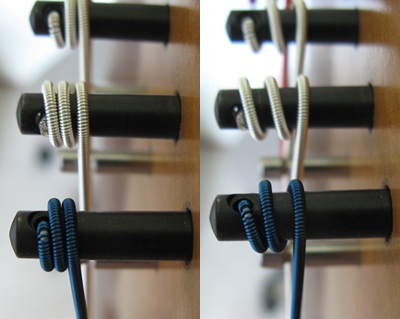|
Thormahlen
Harps
Owners Manual
Packing and unpacking |
The video link below shows you how to unpack your Thormahlen harp
so that you can save your box in case you ever need it. Please watch
this before you receive your harp so you'll know exactly how to unpack
your harp.
At the end are also some helpful hints on carrying your
harp in it's case. Let us know if you have any questions. Time:
7:08
|
|
Thank you for purchasing a Thormahlen Harp. It is a fine
musical instrument requiring a minimum amount of maintenance. Here are
some things to know in order make your relationship with your harp a
happy one.
Tuning
New harps usually need to be tuned regularly so the strings can continue
stretching. Tune your harp everyday at least once, and in a couple of
weeks it should be holding its tune rather well.
When you get your Thormahlen Harp, it will be tuned to the
key of Eb, unless you specified otherwise. This gives you the most options
for playing in the most common keys. If you put all your B, E, and A
levers up, you will be in the key of C.
If this is something that is too confusing to you at this
time, you can tune your harp to the key of C simply by putting all your
levers down and tuning all the notes to natural. You will probably want
to do this with an electronic tuner. We recommend and carry the Korg
CA-30 and the Korg DT-3. You can also purchase a mic clip that can be
attached to your tuner.
It’s best to tune your harp with the levers down,
especially where the strings have windings. The lever may get caught
on one of the windings and not give you a true pitch particularly if
you lower that lever to play in another key.
Here are some tuning
instructions that should help you.
Tuning Pins
The tuning pins are tapered so that the diameter of the pin gets larger
on the side that the tuning key fits. Sometimes a tuning pin will
slip. If this happens, de-tune the string about a half of a turn,
and then as you turn the pin to tune the string back up, push the
pin in. You can provide counter pressure by bracing the neck of the
harp with your left hand, while pushing in with the key in your right.
You can see a demonstration of this at: http://www.youtube.com/watch?v=WvRomtaLDHM
Another really good video on this is from Steve Moss:
https://www.youtube.com/watch?v=T_lxIj0OjyQ

If the string angles towards the neck from the
tuning pin, it could be putting back pressure on the tuning pin and
pushing it out of the hole. This is more likely to happen in the low
bass wires. The remedy here is to detune the string and stretch out
the windings so they run straight up and down instead of at an angle.
If there aren't enough windings, you probably have to put on a new
string. Cut your string about 2" longer than the string length
you need to allow for the extra windings.
Bridge Pins
Sometimes a string will pop off the bridge pin. Often this is because
as the string stretches and tunes up to pitch, there are too many windings
on the tuning pin. This causes the string above the bridge pin to be
at a steep angle to the tuning pin and it pops off the bridge pin. The
solution is to completely unwind the string until it is going straight
up the hole of the tuning pin. Pull it up through the tuning pin about
1/2-3/4 inch, re-knot the string and tune it back up. Cut off the extra
1/2-3/4 inch of string. This should take at least 1 winding out of the
string and it should help it stay on the bridge pin.
Strings
Occasionally strings break for no reason, often in the middle of the
night when no one is playing the harp. You can buy individual strings
or an entire string set from us. All of our harps use the same bass
wires.
Our gut string sets use the pedal harp numbering system
which starts at the 1st octave E. With the top 5 strings of our folk
gut harp being nylon, this puts the first gut string on our harp, the
second octave e, as the #8 string of the folk gut set. When ordering
a string, it is best to go by the note name and string number, counting
#1 from the top of the harp to make sure you get the right string.
Our website has infromation on string tying and trouble shooting
solutions complete with videos to help. Go to: http://www.thorharp.com/pages/strings.htm (click on string tying)
If
you want to change the kind of strings you have on your harp, please
call us to discuss the possibilities and proceedures for doing so.
It is a little more complicated than just changing the strings and
not all strings work on all of our harps.
We highly recommend that
you purchase an extra set of strings. They don’t break often but when they do, it’s handy to have a
replacement available right away.
The Ceili uses the Flourocarbon or folk gut strings.
Strings on any of our harps are not directly interchangeable but you
can switch from one to the other with a lever regulation.
DO NOT PUT CONCERT GUT STRINGS ON A HARP BUILT FOR NYLON OR FOLK HARP
GUT.
Some videos on string tying:
string
tying webpage
String
tying video for the upper strings (1-22)
String
tying video for the midrange Folk Gut (#23-29) (see visual instructions
here)
Putting the string on the tuning pin
Putting on a Bass Wire
Levers
The Camac Levers on your Thormahlen harp provide a smooth action, purity
of tone and ease of adjustment. We offer a lever regulating tool kit
which you can see on our website.
Cleaning
your harp
The lacquer finish used on your harp does not require a lot of care.
If your harp gets dirt or grime on it, simply wipe it down with a damp
cloth, and follow it immediately with a dry rag. Since the wood is finished
with lacquer, you should not use waxes or cleansers on it. Please consult
us before using any cleaning or polishing products on your harp.
The
Harp Case
When putting the harp in the case, we recommend opening the harp case
entirely and laying the harp down with the lever side up. We also recommend
putting the strap over your head resting it on the opposite shoulder
when carrying the harp in its case.
Where to keep your
harp
The harp should be kept out of direct sunlight, away from any heat source
or draft. It is best if the humidity of the room in which the harp is
kept is between 40% & 60% and the temperature between 50F - 75F.
Humidifiers should be used if you live in a dry climate. Our warranty
does not cover harps that crack from neglect.
Please call us if you have any questions or problems with your new harp.
We will be happy to help you. And thanks again for purchasing a Thormahlen
Harp.
Sharon & Dave Thormahlen
|

